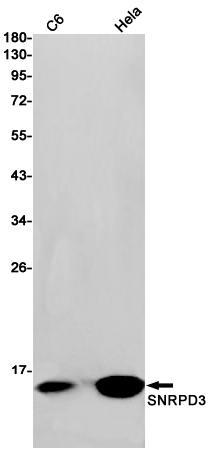
| WB | 1/500-1/1000 | Human,Mouse,Rat |
| IF | 咨询技术 | Human,Mouse,Rat |
| IHC | 咨询技术 | Human,Mouse,Rat |
| ICC | 技术咨询 | Human,Mouse,Rat |
| FCM | 咨询技术 | Human,Mouse,Rat |
| Elisa | 咨询技术 | Human,Mouse,Rat |
| Aliases | SMD3; Sm-D3 |
| Entrez GeneID | 6634 |
| WB Predicted band size | Calculated MW: 14 kDa; Observed MW: 14 kDa |
| Host/Isotype | Rabbit IgG |
| Antibody Type | Primary antibody |
| Storage | Store at 4°C short term. Aliquot and store at -20°C long term. Avoid freeze/thaw cycles. |
| Species Reactivity | Human,Rat |
| Immunogen | A synthetic peptide of human SNRPD3 |
| Formulation | Purified antibody in TBS with 0.05% sodium azide,0.05%BSA and 50% glycerol. |
+ +
以下是关于SNRPD3抗体的3篇参考文献及其摘要概括:
1. **文献名称**:*SNRPD3 overexpression promotes hepatocellular carcinoma progression via regulating cell cycle and RNA splicing*
**作者**:Li Y, et al.
**摘要**:研究利用SNRPD3抗体(Western blot和免疫组化)发现SNRPD3在肝癌组织中高表达,且与患者预后不良相关。实验表明SNRPD3通过调控细胞周期相关基因和RNA剪接过程促进肿瘤增殖和转移。
2. **文献名称**:*The spliceosome component SNRPD3 regulates the senescence-associated secretory phenotype*
**作者**:Wang H, et al.
**摘要**:该研究使用SNRPD3抗体(免疫荧光和ChIP-seq)探讨SNRPD3在细胞衰老中的作用,发现SNRPD3通过调控炎症因子mRNA的剪接,影响衰老相关分泌表型(SASP),为衰老相关疾病提供潜在靶点。
3. **文献名称**:*SNRPD3 interacts with MYC to promote tumorigenesis and drug resistance in breast cancer*
**作者**:Zhang Q, et al.
**摘要**:通过SNRPD3抗体(Co-IP和免疫沉淀)验证SNRPD3与MYC蛋白的相互作用,揭示其通过增强MYC信号通路介导乳腺癌化疗耐药,靶向SNRPD3可逆转耐药表型。
以上研究均依赖SNRPD3抗体进行蛋白表达检测或功能机制探索,涵盖癌症进展、衰老和耐药性等领域。
The SNRPD3 antibody targets the small nuclear ribonucleoprotein D3 polypeptide (SNRPD3), a core component of the spliceosomal Sm core complex involved in pre-mRNA splicing. SNRPD3. also known as SmD3. is part of the SNRNP complex, which assembles with U1. U2. U4/U6. and U5 snRNAs to form the spliceosome. This protein contains a conserved Sm domain that facilitates its interaction with other Sm proteins (SNRPD1. SNRPD2. etc.) to form a heterotrimeric complex, binding to uridine-rich snRNA regions. SNRPD3 antibodies are widely used in research to study spliceosome assembly, RNA processing mechanisms, and subcellular localization via techniques like Western blotting, immunoprecipitation, and immunofluorescence.
These antibodies help investigate SNRPD3’s role in cellular processes, including its dysregulation in diseases. For instance, SNRPD3 overexpression has been linked to cancer progression, where it may promote tumor growth by altering splicing of oncogenic transcripts. Antibody validation often involves knockdown/knockout cell lines to confirm specificity. Commercially available SNRPD3 antibodies are typically raised in rabbits or mice, with applications in basic research and clinical studies exploring connections to neurodegenerative disorders, viral infections, and malignancies. Understanding SNRPD3’s function through antibody-based assays contributes to insights into splicing-related pathologies and potential therapeutic targets.
×